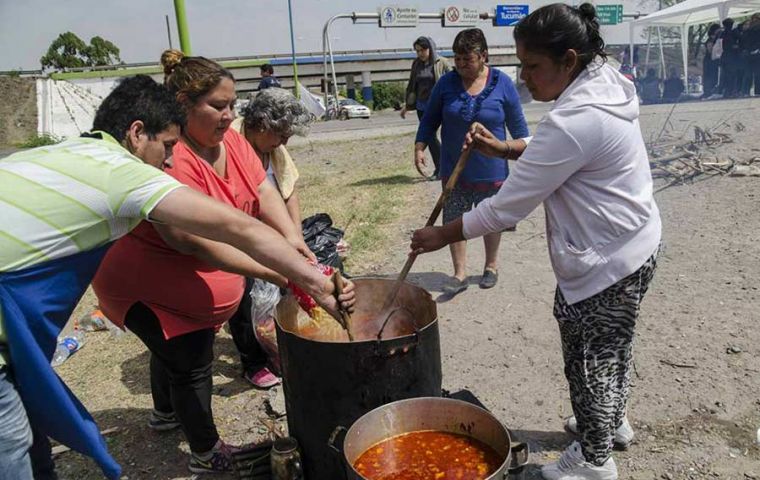MercoPress. South Atlantic News Agency
Argentina's statistics bureau finds 4 out of 10 people are poor
 Indec's latest report released last week showed 18.8 million Argentine residents were technically poor (Pic TELAM)
Indec's latest report released last week showed 18.8 million Argentine residents were technically poor (Pic TELAM) The latest data from Argentina's National Institute of Statistics and Censuses (Indec) show that the poverty index has reversed a meager 1.4 % during the first half of 2021.
It represents a slow comeback from the 42% registered in the previous semester and still far from the 32.2% of five years ago and even farther away from the 24.7% of a decade ago.
Projections from Indec's report released last week show 18.8 million Argentine residents are technically poor, which means that their income is insufficient to meet basic expenses. Among this group, almost five million cannot even afford to buy food and must resort to free canteens or other types of aid.
In the middle of the year, the per capita monthly income of the poorest tier of Argentines was around AR $ 5,675 (about US $ 31, at the unofficial exchange rate, which is the only one available for the largest part of society). On the other hand, the highest earning group of Argentines raked in a monthly average income of AR $ 142,116 pesos (around US $ 785 by the same standards).
Buenos Aires, the country's richest city, also showed food insecurity, as 7.5% of households could not be certain of their daily food supply, according to the social debt Observatory of the Argentine Catholic University. That figure rose to 27.6% of households in the less-favored areas surrounding Buenos Aires.
“In highly inflationary contexts, the higher proportion of food expenditures implies greater difficulty in reaching adequate food consumption. This decreased ability to access food translates into situations of food insecurity. Undoubtedly, as the study shows, the problem would have been much more serious without the programs - public and private - of food assistance,” highlighted the Observatory in a separate report.
According to Indec, a slight reactivation of the economy after lifting most COVID-19 restrictions can be noticed, but the improvement hardly reaches the most vulnerable sectors, who rely on state subsidies for their survival.
A high yoy inflation -51.4%- plays a key role in slowing down the return to prepandemic levels.
”The value that we knew today is a relatively small decline, which leaves us at much higher values than before the pandemic. This is a characteristic of Argentina, which in the end of its different crises is left with a higher poverty floor than it had before,” explained Economist Leo Tornarolli from the Center for Distributive, Labor and Social Studies (Cedlas) at the National University of La Plata.
“In the next six months it is expected that poverty will pierce 40% due to the normalization of the health situation and the stimuli that are being given due to the electoral process. The Government has to recover its image and is increasing spending, which will reduce poverty in the short term, but nothing guarantees that this will be the case next year,” he added.
Social movements demand more funds, but also sources of work, since 9.6% of the population is unemployed and just as many are underemployed, meaning they work fewer hours than they are willing to.
After years of a sharp drop in the purchasing power of money, having a full-time job does not secure an income above the poverty line. In three and a half years, 7 million people fell into poverty, at a rate of 5,500 daily.
As per Indec figures, there are 18.5 million people living in poor households in Argentina. Homelessness has reached 10.7% of the population or 4.9 million people, a 0.2 increase from 2020. These are the people who live in households where the cost of the Basic Food Basket (CBA) for their members is unattainable, meaning people will lack the minimum calories required to avoid a situation of malnutrition. Just over 150,000 people fell into this situation over the past year.
Between June 2020 and June 2021, the average salary rose just 43%, losing 7.2% against inflation. But on the other hand, employment did recover in the second quarter of this year compared to the same quarter of 2020. Almost 12 million people were recorded as having a job, against the 9.5 million from a year before.
According to the Indec report, the gap between poor households and the value of the Total Basic Basket was 40%, against 41.9% in the previous semester. And among age groups, poverty hits 54.3% of children from up to 14 years of age. Between 12 and 17 years of age, it rises to 57.8%. Almost two out of every ten teenagers in Argentina are exposed to malnutrition.




Top Comments
Disclaimer & comment rulesCommenting for this story is now closed.
If you have a Facebook account, become a fan and comment on our Facebook Page!